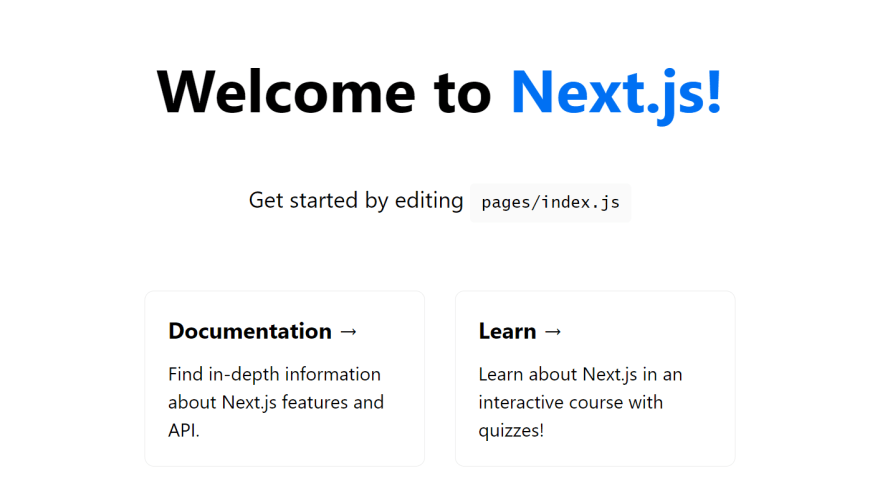An Interest In:
Web News this Week
- April 2, 2024
- April 1, 2024
- March 31, 2024
- March 30, 2024
- March 29, 2024
- March 28, 2024
- March 27, 2024
NextJS deployment via AWS CodeCommit / Amplify
Hey All , Let's see how to add the NextJS starter code in an AWS CodeCommit repo and deploy it with AWS Amplify. I am using the Cloud9 IDE for this exercise. You may follow these steps on any Linux/Unix based machine though.
I am using aws cli v2. You may upgrade the version if required. Also ensure you have setup the CLI with the required authentication config.
$ aws --versionaws-cli/2.4.27 Python/3.8.8 Linux/4.14.262-200.489.amzn2.x86_64 exe/x86_64.amzn.2 prompt/offThe user id I'm using has administrator permissions , so I shouldn't have any issues while creating the repo. If not an admin, the IAM user should be setup with CodeCommit policies.
Let's go ahead and create the repo.
$ aws codecommit create-repository --repository-name next-js-boilerplate --repository-description "Boilerplate code for NextJS" --tag "code=JavaScript,framework=NextJS"{ "repositoryMetadata": { "accountId": "<account-id>", "repositoryId": "<repository-id>", "repositoryName": "next-js-boilerplate", "repositoryDescription": "Boilerplate code for NextJS", "lastModifiedDate": "2022-03-19T08:17:28.327000+00:00", "creationDate": "2022-03-19T08:17:28.327000+00:00", "cloneUrlHttp": "https://git-codecommit.us-east-2.amazonaws.com/v1/repos/next-js-boilerplate", "cloneUrlSsh": "ssh://git-codecommit.us-east-2.amazonaws.com/v1/repos/next-js-boilerplate", "Arn": "arn:aws:codecommit:us-east-2:<account-id>:next-js-boilerplate" }}The repo is created and should appear in the list of repositories.
$ aws codecommit list-repositories --output textREPOSITORIES <repository-id> next-js-boilerplateCan be checked on the AWS console too, on the browser.
We are going to connect to the repo via SSH for which we have to upload the SSH public key to the AWS user account. But before that you have to ensure the SSH key is already generated. You may refer to this link if you want to know how to generate the SSH key pair. The public key in my system is at the standard location i.e. ~/.ssh/id_rsa.pub.
Let's upload this key and retrieve the public key id.
$ SSHPublicKeyId=$(aws iam upload-ssh-public-key --user-name nc --ssh-public-key-body file://~/.ssh/id_rsa.pub --output text --query SSHPublicKey.SSHPublicKeyId)Setup SSH config, and modify its permission so that only the owner(current user) of the file can access it(Read + Write).
$ cat > ~/.ssh/config <<EOFHost git-codecommit.*.amazonaws.com User $SSHPublicKeyId EOF$ chmod 600 ~/.ssh/configLet's get the GIT SSH URL and then clone it.
$ gitUrl=$(aws codecommit get-repository --repository-name next-js-boilerplate --query repositoryMetadata.cloneUrlSsh --output text) $ git clone $gitUrlCloning into 'next-js-boilerplate'...warning: You appear to have cloned an empty repository.We have successfully cloned the repository, lets add some code to it. We can use npx for bootstraping a NextJS project. You may install nodejs/npm ) if its not already present in your system
$ cd next-js-boilerplate/$ npx create-next-app@latest What is your project named? next-js-boilerpateThis installs the NextJS project, and it also creates a sub directory with the same name, so let's move contents from the sub directory to the main directory.
$ mv next-js-boilerplate/.* .$ mv next-js-boilerplate/* .$ rmdir next-js-boilerplate/$ ls -a. .eslintrc.json .gitignore node_modules package-lock.json public styles.. .git next.config.js package.json pages README.mdThe code can now be pushed to the repo.
$ git statusOn branch masterNo commits yetUntracked files: (use "git add <file>..." to include in what will be committed) .eslintrc.json .gitignore README.md next.config.js package-lock.json package.json pages/ public/ styles/$ git add .$ git commit -m 'adding nextjs boiler plate code'$ git pushWe can verify this on the AWS console.
we can now deploy this code via AWS Amplify, I am going to use the GUI for this.
Search for Amplify, create a new app, and then choose CodeCommit.
The next step is as follows, to select the correct repo and branch.
Jus continue to the final step with no changes, and deploy.
In a few minutes , the app should be deployed. We should see the 4 stages(provision, build, deploy and verify) to be successful. There should also be a testing stage, which we haven't used here, as no tests are written.
You should now be able to view the application by clicking on the https link provided above.
Thus, we have gone through some parts of CodeCommit and Amplify. CLI was used with CodeCommit, just to see the power of AWS CLI and I think many cloud operations are possible with it. Note that we can customize Amplify deployments with environment variables, build command modifications etc.
That's it for now, thanks for reading...
Original Link: https://dev.to/aws-builders/nextjs-deployment-via-aws-codecommit-amplify-6oj
Dev To
 An online community for sharing and discovering great ideas, having debates, and making friends
An online community for sharing and discovering great ideas, having debates, and making friendsMore About this Source Visit Dev To

